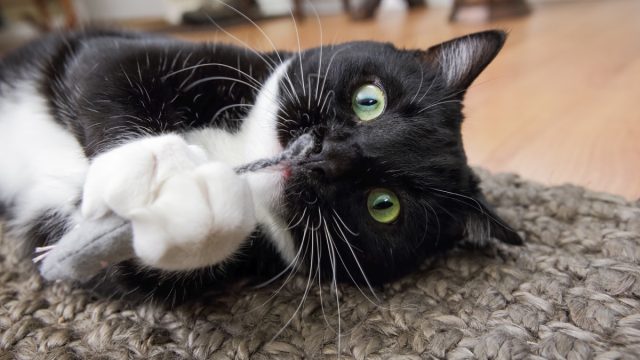Why Are Cats Obsessed with Catnip?

It’s a question as old as time (or at least Egyptian papyrus): Why do cats like catnip so much? A sprinkle of the stuff on a toy or scratcher and a cat’s eyes bug out, before the little fella writhes around on the floor, tail swinging back and forth, in a state of unmistakable euphoria. One wouldn’t be incorrect to christen the stuff a feline narcotic. And yet, cat parents the world over have no idea what, exactly, is going on.
Technically, catnip, is an herb, formally known as Nepeta cataria, and a member of the mint family. But what gets the cat going is a chemical compound within the plant’s leaves and stems known as nepetalactone. Sniffing it triggers a chemical reaction in the feline’s brain, imitating pheromones and creating something of an aphrodisiac high.
“It creates a sexual response, which explains why cats high on catnip may mimic the behavior of a female in heat,” explains Pam Johnson-Bennett, a cat expert and author of CatWise. “The cat is essentially reacting to an artificial cat pheromone that resembles the urine scent of an in-heat female.”
Of course, in the same way that different humans react to different substances in different ways, the effects catnip has on different kitties runs the gamut. Some roll around and act nuts. Others rub against it or chew it to try to release more of the nepetalactone. (Interestingly, while it’s the inhalation of the herb that gets cats excited, if they actually eat it, the catnip can act as a sedative, causing the animals to chill out.) Others—about 50 percent, by some estimates—don’t react at all.
“The catnip response is hereditary,” says Johnson-Bennett. “The cats that do have the response gene have probably always been able to enjoy catnip provided the plant, in fresh or dried form was available.”
Whatever their sensitivity, cats don’t respond to the stuff until they reach sexual maturity—about six months of age. But when you do introduce your young pet to catnip, be careful. Also, you should factor gender in, too. “Some male cats may display aggression while enjoying catnip, so in a multi-cat household, it’s wise to initially offer catnip separately until you’re sure of the response,” says Johnson-Bennett.
Owners may be startled by the response of their usually docile pets when the catnip is released and might feel unnerved by the intoxicated craziness on display. But rest assured: this euphoric high is non-addictive and totally safe. You won’t have to worry that a few too many doses of the stuff will cause your pet to develop a chemical dependence or some other medical condition.
But while it’s not possible for the cat to overdose on the stuff, they can build up an immunity to catnip. To that end, Johnson-Bennett suggests avoiding overexposure. “Catnip should only be offered a maximum of two or three times a week,” says Johnson-Bennett. “Don’t leave catnip-infused toys around all the time. If cats are constantly exposed to catnip, they can develop an immunity to its effect.” And no one wants that.
To discover more amazing secrets about living your best life, click here to follow us on Instagram!